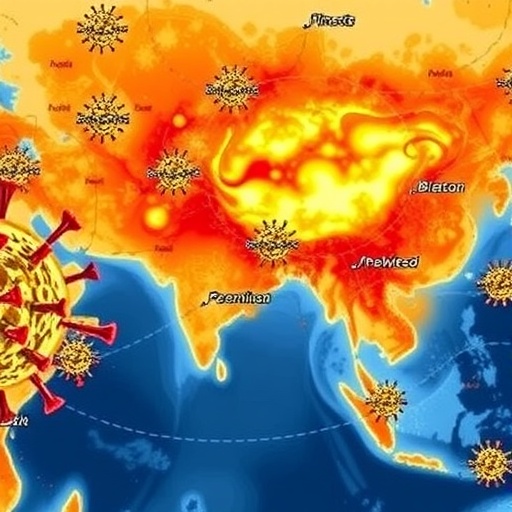In an era where the global battle against COVID-19 remains relentless, a new ground-breaking study has shed light on how various SARS-CoV-2 variants maintain exceptionally high airborne transmissibility, employing distinct mechanisms to ensure their survival and spread. Conducted by Zhou, Sukhova, Frise, and their colleagues, this research, published in the prestigious journal npj Viruses in 2025, unravels the complex interplay between viral evolution and airborne spread, providing critical insights into why new variants continue to challenge public health strategies worldwide.
At the heart of the study lies the pressing question that has preoccupied virologists since the emergence of SARS-CoV-2: how do these variants manage to stay so infectious despite significant genetic changes? The answer, as Zhou et al. reveal, is not uniform. Instead, each variant harnesses unique modifications within its structural proteins or replication mechanisms to maintain or even enhance its aerosolization potential, viability in airborne droplets, and ultimately, its infectiousness.
The airborne transmission of respiratory viruses like SARS-CoV-2 is a complex phenomenon dependent on multiple factors including viral load, particle size, environmental stability, and receptor binding affinity. Previous research established that the original Wuhan strain could aerosolize efficiently, but subsequent variants presented a puzzle—some demonstrated increased spread without apparent changes in receptor binding strength, while others showed altered environmental resilience.
This study employs a multidisciplinary approach, combining virology, aerosol physics, and computational modeling to dissect the airborne transmissibility traits across dominant variants including Delta, Omicron, and recent lineages emerging in 2024. Utilizing high-containment laboratory aerosol chambers, the researchers generated controlled aerosols containing live virions under simulated respiratory conditions, monitoring particle stability and infectious titers over time.
A fascinating discovery lies in how different variants adapt their spike protein conformations and surface properties, influencing aerosol stability. The Delta variant, for example, was found to have a more resilient spike structure that resists degradation in smaller aerosol particles, thereby extending airborne viability. In contrast, Omicron variants exhibited mutations that augment receptor binding but reduced physical stability; however, this was compensated by a higher replication rate in the upper respiratory tract, resulting in greater emission of virus-laden particles.
Further detailed is the role of non-spike proteins, which, until recently, garnered less attention. Zhou and colleagues identified mutations in the nucleocapsid and envelope proteins that influence viral aggregation and droplet formation dynamics, subtly modulating aerosol generation and persistence. These findings reveal a sophisticated, multi-protein strategy adopted by variants to maximize their transmission potential.
Temperature and humidity are known to affect viral survival in aerosols, yet the study highlights that each variant reacts differently to environmental conditions. For instance, recent variants maintain infectivity across a broader humidity range, challenging previous assumptions about seasonal transmission patterns. This adaptability may underlie the persistent transmission seen in diverse climates and seasons, complicating prediction models.
Moreover, computational fluid dynamics simulations incorporated in the study illustrate how variant-specific alterations impact deflection and settling of aerosols in indoor settings, influencing the effective range of airborne transmission. Such insights emphasize that public health interventions such as mask design and ventilation systems must consider variant-specific airborne behavior rather than relying on a one-size-fits-all model.
The implications extend beyond virology to the design of epidemiological models and infection control policies. Recognizing that different variants optimize transmission through distinct airborne pathways encourages a nuanced approach. It supports the idea that enhanced surveillance of viral aerosol properties could anticipate shifts in transmission patterns and guide proactive containment strategies.
Crucially, the research stresses the continued relevance of airborne transmission as the dominant mode of spread for SARS-CoV-2, even as the virus evolves. Respiratory hygiene and indoor air quality management remain frontline defenses, especially with variants capable of adjusting aerosol characteristics and escaping immune recognition.
This comprehensive analysis addresses outstanding questions about why SARS-CoV-2 variants persistently defeat previous control measures: it is not simply a matter of increased infectivity but of complex, multifaceted adaptations targeting the airborne route. The convergence of molecular biology, physical science, and epidemiology showcased in this work marks a paradigm shift in understanding respiratory virus transmission.
Looking ahead, the authors advocate for integration of aerosol transmissibility data into vaccine and antiviral strategy assessments, to anticipate and mitigate future variant-driven surges. They also highlight the need for real-time monitoring of viral aerosol properties in public spaces, leveraging novel sensor technologies to achieve dynamic risk assessment.
Ultimately, Zhou et al.’s study serves as a roadmap for the global scientific community in the ongoing war against COVID-19. It underscores that in a microscopic world where subtle molecular tweaks can translate to pandemic-scale consequences, only a multidisciplinary and adaptive response can hope to keep pace with the virus’s airborne arsenal.
In conclusion, the persistence of high airborne transmissibility among SARS-CoV-2 variants arises from an intricate array of viral adaptations tailored to optimize aerosol stability, particle generation, environmental resilience, and host interaction. These findings compel a re-evaluation of current airborne infection mitigation strategies, emphasize the importance of continuous viral monitoring, and chart a path for more robust and versatile public health tools in the face of evolving respiratory threats.
Subject of Research: Airborne transmissibility mechanisms of SARS-CoV-2 variants
Article Title: SARS-CoV-2 variants retain high airborne transmissibility by different strategies
Article References:
Zhou, J., Sukhova, K., Frise, R. et al. SARS-CoV-2 variants retain high airborne transmissibility by different strategies. npj Viruses 3, 39 (2025). https://doi.org/10.1038/s44298-025-00120-1
Image Credits: AI Generated




